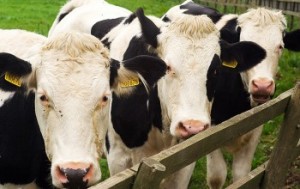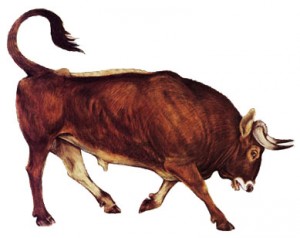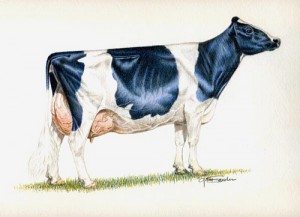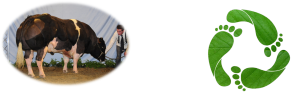By: Gwendolyn Anderson
“Staying Good While Playing God”
~P. Sandoe et al.

A look into the ethical debate surrounding selective breeding on dairy farms
Selective Breeding
Since cattle domestication, humans have been actively involved in the selection of animals, leading to domestication.
With the rediscovery of Mendelian genetics as well as molecular genetics development, humans have more control over breeding animals than ever before. Producers have the ability to change animals intentionally with the option of maintaining or improving on current animals or reviving old breeds. Ultimately, this has lead to a reduction in the number of cattle breeds used for milk.
The Ethical Question of Selective Breeding
Two Approaches: 1. “quality of life” approach: Breeding is only successful if it increases the quality of the animal’s life 2. “preservationist approach: Breeding is only successful if it conserves species and promotes naturally occurring genetic events.
Utilitarian Approach
According too the classic utilitarian view on animal breeding, the sole concern of selective mating should be to obtain the highest level of pleasure minus suffering for both the animals and the humans. The human interest in the equation is typically buying cheap food as well as freeing up resources for other purposes (i.e., more land for grain production vs. land for raising cows). A sharp conflict can be found when breeding for production traits increases traits that negatively impact health. For example, mastitis (a disease that is characterized by a painful inflammation of the udder) has been genetically correlated to high milk yield. From the utilitarian standpoint, animal welfare has HIGH ethical significance.
THE GOAL: CUMULATIVE IMPROVEMENT
The goal of genetic selection on dairy farms has become successful multitrait selection: improving health, calving performance, production performance, and fertility simultaneously. Typically, dairy farms develop balanced breeding goals that include both functional traits as well as productive traits. Today, it is well recognized that these productive traits have economic benefits as well as animal welfare benefits.
Common Areas of Ethical Debate Within Genetic Selection
Animal Integrity
- Selectively breeding livestock is a form of genetic change that violates the integrity of species.
Biodiversity
- By selectively breeding animals, the gene pool is being limited and therefore a process of losing genetic diversity is initiated.
- The use of artificial insemination in the dairy industry has resulted in only a few sires having a large number of offspring.
- Technologies such as artificial insemination, in vitro fertilization, and semen storage allow for continued biodiversity by preserving genetics that could be sought after in the future (for example, resurrecting extinct breeds).
Efficiency & Environment
- Rapid growth in production animals has the potential to decrease health, resulting in animal welfare issues.
- By genetically selecting these animals, humans have made a hybrid that would not exist in the wild, causing the species to be different than the species that would have arose during natural selection
- Increased feed efficiency of animals frees up resources for other uses (such as grain production) and allows for a positive impact on farmer and consumer economics.
- By focusing on multi-trait selection, farmers have managed to create an efficient animal that is also a healthy animal.
- Without genetic selection, dairy farmers would not be able to produce enough food for the world, endangering food security across the globe.
- Dairy farmers today produce more product with less resources than ever before. This is partly a product of management changes but is also largely due to selective breeding.
Health & Welfare Conditions
- Increased milk yields have been shown to have an association with mastitis incidences as well as reproduction issues in dairy cows.
- Rapid growth, a result of selective breeding for productivity, has the potential to result in a negative impact on cow health.
- By narrowing the gene pool and limiting the sires being used, there could be an increase in congenital defects.
- However, with advancements in genomic testing and the ability to determine the presence of genes causing congenital defects and disease, the incidence of these congenital defects can be heavily controlled through selective mating.
- Selective breeding has lead to improved conformation in dairy cattle, which leads to an increased quality of life for the cow.
- By selectively breeding cattle, farmers can attempt to improve the behavior (i.e. reduce aggressiveness and skittishness) of cattle in their herd, resulting in not only benefits to the herd (less injuries due to fighting/aggressiveness) but also benefits to the farm (less injuries due to aggressiveness, less economic losses to to cow injuries).
- Selective breeding has also lead to focus on increasing animal longevity and disease resistance in cattle, allowing cows to live longer and healthier lives.
Animal welfare is a primary concern when breeding ethics are called into question, even if ethicists disagree about what breeding goals and techniques are questionable.
It is all about balance!
Proper selective breeding relies on a balance between the ethical, commercial, consumer, and legal concerns. The focus today remains on cumulative improvement, focusing on both production and health traits. A greater understanding of breeding programs and effects has lead to selective breeding being a valuable tool, both for farmers and their animals.
Works Cited
European Forum of Animal Breeders. “Code-EFABAR.” Updated 2015/2016. Accessed May 11, 2015.
Huson, Heather. “Cattle Domestication & Breed Development.” ANSC 3310: Applied Dairy Genetics. Presentation at Cornell University, Ithaca, NY, Feb 3, 2015.
Olsson, Anna, Christian Gamborg, and Peter Sandoe. “Taking Ethics into Account in Farm Animal Breeding: What Can the Breeding Companies Achieve.” Agricultural and Environmental Ethics 19, no. 1 (2006): 37-46. Accessed May 11, 2015.
Robinson, Pual. “Farm Animal Breeding & Society.” European Forum of Farm Animal Breeders. September 21, 2000. Accessed May 11, 2015.
Sandoe, P, B L. Nielsen, L G. Christensen, and P Sorensen. “Staying Good While Playing God – The Ethics of Breeding Farm Animals.” Animal Welfare 8 (1999): 313-29. Web. 10 May 2015.
Image Credits
Aurochs International. “Bringing sustainability to life…” Landscape, Planning and Sustainability. Web. Accessed 11 May 2015.
Virgen de Lourdes. “Los Origenes, Bravura, Trapio. Web. Accessed 11 May 2015.
Creation Wiki. “Figure illustrating the founder effect” Founder Effect. Accessed 12 May 2015.
“A bovine embryo flush.” Animal Reproductive Technologies. Web, Accessed 12 May 2015.
Nah, Madhurima. “Ecological footprints” Comprehension activity: “Ecological footprints”. 9 June 2014. Web. Accessed 12 May 2015





